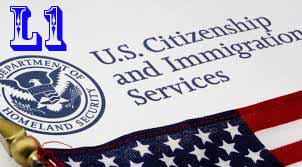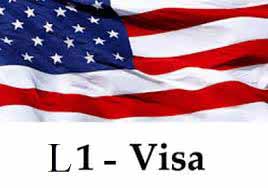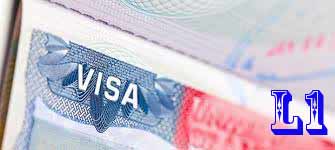What Is A L1 Visa?

An L-1 visa is also known as the Intracompany Transferee. An L1 visa is essentially a work permit for the U.S. and can be valid for up to 3 years. There is a possibility of extending the L-1 visa but for no longer than an extra two years. The maximum stay with extensions can be a total of 7 years. This work permit is only available to employees of a company that has offices in both the U.S. and abroad. With this visa the employee can relocate to the company’s U.S. offices, as long as they have worked for this company abroad for a minimum of 1 year within the last 3 years prior to admission.
What Does A L-1 Visa Enable & Qualifications For An L-1 Visa?
-
- The L-1 visa is only available to employees of a company that has offices in both the U.S. and abroad.
- You must have worked for this company abroad for a minimum of 1 year within the last 3 years prior to admission.
- The U.S. and the non-U.S. employers must be either:
- Parent and subsidiary
- Branch and headquarters
- Sister companies owned by mutual parent
- Affiliates owned by the same people in about the same percentages
- If one of the above has not yet been established, then the L-1 visa allows the international company to send an employee to the U.S. to establish one (this comes with additional requirements)
Categories For The L1 Visas
There are 2 types of L1 visas in existence.
L-1A
- for executives and managers
- status can be valid for up to 7 years
- This visa is initially issued for a 3 year period and can be extended in two year increments until the individual has reached a total of 7 years.
- This visa may be extended if the individual resides in and commutes from Canada or Mexico to the United States for employment.
L-1B
- for workers with specialized knowledge
- status can be valid for up to 5 years
- Similarly to the L-1A visa, the L-1B visa is also initially issued for a 3 year period and can be extended in two year increments until the individual has reached a total of 5 years.
- This visa may be extended if the individual resides in and commutes from Canada or Mexico to the United States for employment.

When their status is up, in both cases, they will have to go work abroad again for at least one continuous year for the parent, subsidiary, affiliate or branch office of the U.S. company.
Types of Procedures For The L-1 Visa?
Two types of procedures exist when applying for the L-1 visa:
- Regular L1 visa. This type of L-1 visa is applied for and approved for each person separately by the USCIS. For this type of procedure, the company must file a written request with the USCIS and each one is evaluated individually. This type of L-1 can be extended within the U.S; OR
- Blanket L-1 Visa. This type of visa is only available to certain employers who meet the criteria. This type of procedure means that the company has already qualified for the issuance of L-1 visa; therefore, the individual applicant will only need to file a copy of the approved blanket written request, along with other documentation of their personal qualifications with the U.S. embassy that has jurisdiction over their place of residence.
- This type of L1, in order to extend the visa, the individual must file a brand new L1 application and this will extend his/her status; however, in order to get the actual visa within the passport renewed, the individual must go back the U.S. embassy where they originally received their visa and renew it there (this must be done personally).
Dual-intent is allowed in regards to the L-1 visa, persons who claim that they plan to immigrate to the U.S. cannot be denied an L1 visa on that basis.
Does Your Business Qualify For An L1 Visa:
1) The new U.S. office requesting the L1 visa must have an ongoing corporate relationship with the international company where you have been employed as any of the following: manager, executive, or worker with specialized knowledge. In other words, the U.S. and the non-U.S. employers must be either:
- Parent and subsidiary
- Branch and headquarters
- Sister companies owned by mutual parent
- Affiliates owned by the same people in about the same percentages
2) An appropriate amount of physical space must be secured for a new office. The amount of physical space varies on the nature of the business. This can be done so by leasing, purchasing, or other means of obtaining the space.

3) If you are applying to the U.S. to set up a new office, you have a limit of one year to do so. If you would like to apply for an extension to stay in the U.S. longer, you will have to show that the new office meets this requirement (it must be active and operating within 1 year). Generally, in order for a business to be active and operating, it must be able to show that it is are hiring new employees, that it is fulfilling contract orders, that is has a revenue stream, or that it is holding inventory, whatever is applicable.
4) After one year, the office must be able to have a managerial or executive position available where the individual is focusing primarily on managerial and/or executive tasks in order to obtain an extension of the L-1 visa.
5) Another important factor is that while the individual is in the U.S. working on establishing the business there, the business outside of the U.S. must be active and operating during this time.
In Order To Sponsor An Application For An L1 Visa:
- A foreign parent must own at least half of a US subsidiary, and have veto powers over the subsidiary’s actions;
- A US parent must own must own at least half of the foreign subsidiary, and have veto powers over the subsidiary’s actions;
- Affiliate US and international businesses must each be at least half owned by the same parent;
- A US organization with a branch office abroad qualifies, as does a international organization with a US branch (this must be more than just an agent or representative);
- A US organization which employs workers overseas can sponsor such employees for L1’s even if there is no non-US office.
Changing Yours L-1B Status To A L1-A Status:
In order to changer your L1B status to a L1A status, you must file a written request to change status to L1A. An individual may want to do so in order to move into a managerial or executive position. Nevertheless, the request must be approved by the USCIS a minimum of 6 months before the L-1B holder reaches his/her 5 year limit. If this is done, then the L-1B worker will be eligible for the complete 7 years that is usually provided for the L-1A workers.
Necessary Documentation Needed for a L1 Visa:

Documents that are necessary for an L-1 visa application include: information about the existing foreign company, your employment within that company, business plans you have for when you arrive in the U.S., U.S. company documents, and much more. Other documentation necessary is the L-1 application itself which is also known as the I-129.
Advantages of L-1 Visa For Canadians:
If a Canadian citizen is applying for admission as an L-1 under the North American Free Trade Agreement, a written request can be filed at the port of entry when the person applies for admission. Canadians do not have to apply at a U.S. immigration office. What this means is that as long as you have all the necessary documentation, if you are a Canadian Citizen, you can take this to a U.S. port of entry and receive an L1 Visa right then and there.
Contact Us Today!
At Akrami & Associates we have a wealth of experience dealing with L1 visa’s. Call us today and let us help you move forward! At Akrami & Associates, there is Always a Way!